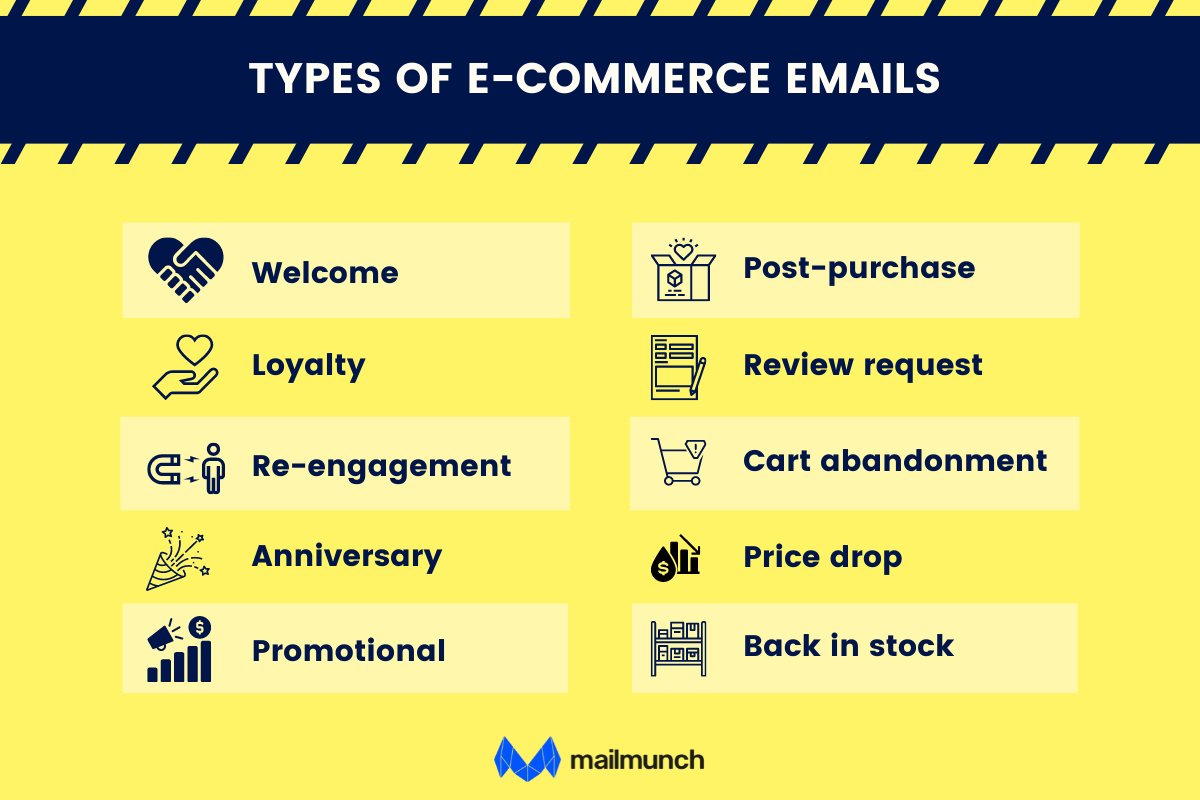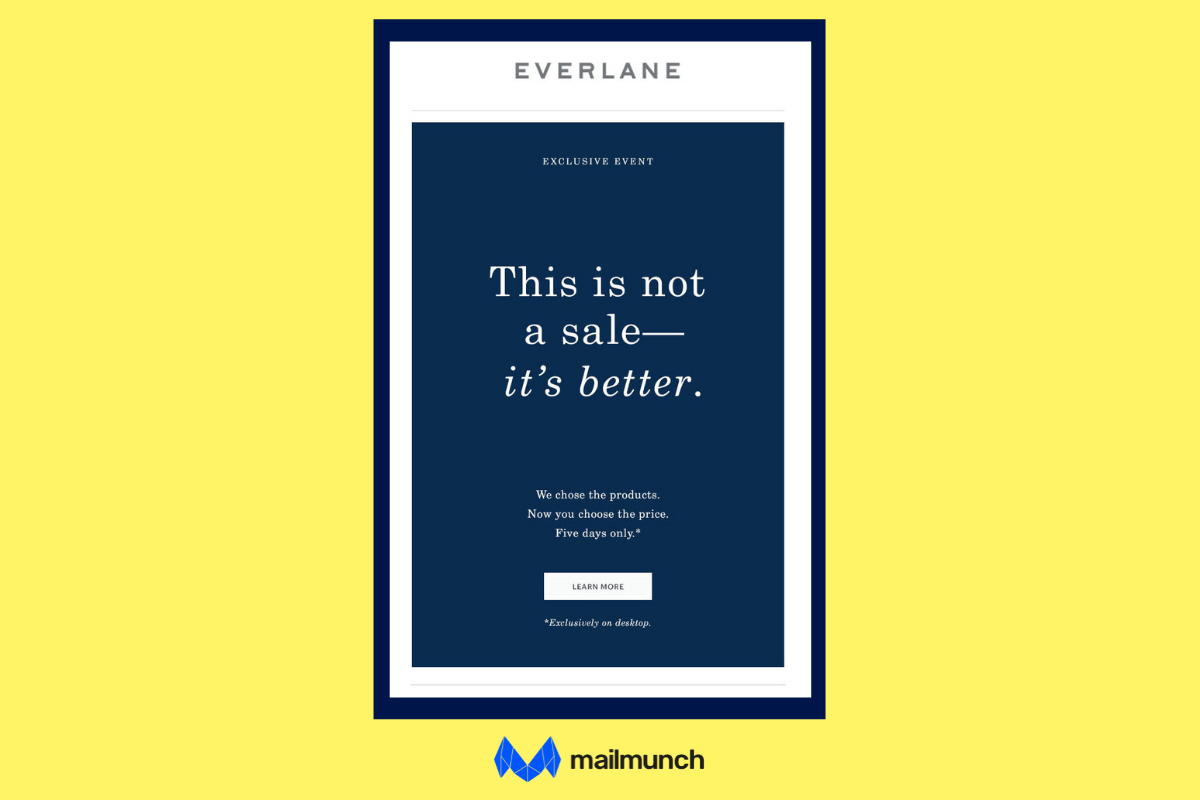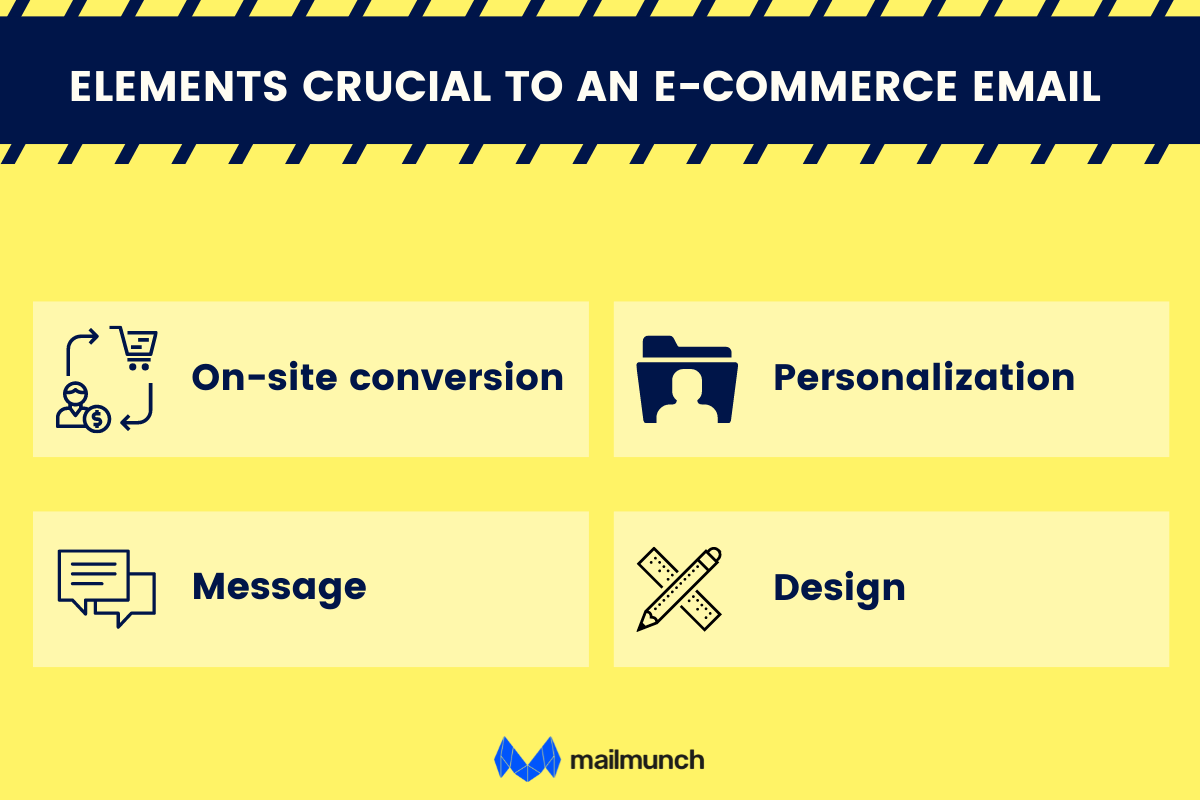
.png)

Last updated on
January 17, 2024
One of the major benefits of running an eCommerce site is your ability to create your own email list. It is the kind of data that no one has but you and it offers you a leg up in the competition since it lets you build relationships and keep your customers engaged. With the rise in online stores, your eCommerce email marketing strategy can play a vital role in scaling up your business.
The industry statistics indicate that the open rate benchmark is 21% with 2.56% of them actually clicking on the website. What’s pretty intriguing and a crucial factor in eCommerce marketing is that 55% of the emails are opened on mobile devices which makes mobile responsiveness one of the biggest factors in determining email success.
With that being set, you don’t just have to settle for the benchmark, right? So here’s a complete eCommerce email marketing guide for you to follow for successful results.
Email marketing is one of the most useful tools especially for eCommerce businesses today since it lets you connect with the customers in a personalized way at a much lesser cost.
eCommerce marketing, as suggested by the name is a powerful marketing strategy that is dependent on emails to promote products and services of an online store to the potential and existing customers. Emails are a very popular form of online communication because of which it is effective, efficient, affordable as well as profitable.
eCommerce email marketing can be as simple as shooting an email to a customer who added items in the cart but left without making a purchase and can be as complicated or tricky as connecting together multiple campaigns to increase sales. The way you utilize your email marketing campaigns is entirely on you. It depends on your business goals, marketing objectives, audience, business growth, etc. The bottom line is that email marketing is basically about fostering and building trust a solid, lasting relationship with customers and it works wonders.
Your emails influence how your customers feel about your brand when they shop from your store whether online or offline. Therefore, you need to engage your customers and keep them on their toes with your email marketing strategy. Or else, with tons of emails bombarded every day by different businesses, you can lose your customers to your competitors.
From PPC advertisements to promotional emails and newsletters, there are many ways you can use digital marketing strategies to generate sales for your online store. However, emails being direct communication from the brand is a more cost-effective and targeted way to reach your customers. Besides, you can easily get a complete picture of your email marketing performance, make adjustments, and hence, enhance efficacy.
The key metrics to track for eCommerce email marketing campaigns include but are not limited to:
For eCommerce business growth, it is essential to streamline comprehensive email marketing campaigns in alignment with the goals, KPIs, and performance metrics. Although you need social media assets as well to scale your business, however, email marketing is factually the best among digital marketing tools to contribute towards customer acquisition.
That’s because brand awareness, first impressions, and user hook can all be utilized in a better way using email marketing. However, a few things you can do to not get marked as “spam” include:
Since we have pretty much covered what exactly eCommerce email marketing is, why is it important and the key metrics to track and monitor the email marketing campaigns, let us talk about the eCommerce email marketing practices, types, and important elements required while designing an email to soar your conversion and sales.
eCommerce email marketing is an email strategy used by eCommerce stores to connect with existing and potential customers through promotions, announcements, and other relevant quality content.
However, if your eCommerce email marketing strategy is underperforming, you should know that you are missing on a huge chunk of sales even if you are a bricks and clicks model.
The statistics mentioned below are likely to explain why email marketing is crucial for achieving eCommerce success:
Not only does email marketing create brand awareness and build credibility but also tends to maintain relationships with customers.
Wondering what kind of emails can you send as an eCommerce store? Here’s a list that will help you out:

A welcome email is the first step towards building a long-term relationship with a customer. It can be a make or break moment so the challenge is to make sure your email is purpose-driven, excites the user, and initiates action. If your welcome email is nothing but a signup receipt, you’re doing it wrong.

To begin with, the fundamental goal of these kinds of messages should be to show the existing and new subscribers what your business is really about – because this is the moment you have more attention than you ever will have again from a user.
While a simple, clean, and easy on the eyes email template is a great place to start, we’d appreciate brands that go beyond the norms by rewarding new users for signing up.
Although customer loyalty does not build overnight, or through just one campaign, however crafting frequent well-targeted email campaigns aiming to nurture your existing and new subscribers to earn customer loyalty isn’t a terrible idea either. It increases the customer lifetime value.

You must have heard of premium membership programs, right? Well, these are the most common types of loyalty programs that brands use to ask users to sign up for an “exclusive” email list that gives them early access to special deals, product releases, and invitations to special events.
For eCommerce platforms, there are usually a plethoric number of “disengaged subscribers” who have not visited your store, purchased from you, or even opened your email for a long time. They are familiar with your brand and products/services but their behavior is peculiar which cannot be fixed.
Therefore, they are usually the warmer audience than strangers. So, re-engagement prompts with offers too good to miss out on are an effective way to get them back on track.

Whether it is a discount offer or competition, make sure to highlight your incentive in a way that cannot be missed. Just a suggestion, make it personalized and make the customer feel special and wanted. No one can let go of that, for sure!
Use phrases like “We miss you!” or “Please come back!” to remind them of their past relationship with your brand.
Who does not like to feel special?
Especially if a business remembers your birthday or anniversary, it takes it to a whole new level. Personalized wishes with coupons, discounts, rewards, and special offers serve to be quite effective in creating customer interaction and building trust.

It is pretty easy, just ask for the date of birth or anniversary date when someone opts into your email list without asking for any additional information. By providing incentives based on the customers’ previous interactions, you can encourage them to make purchase decisions not just on price, but on shared values, engagement, and overall experience of your brand.
Every day we all receive tons of promotional emails, right?
From experience as a consumer, most of these messages are often less strategic and systematic. For instance, we all get tens, hundreds of boring promotional email cliches every month, most of them no one would care to open. Now, this is a disaster. You really have to think these campaigns through.

Unlike other transactional emails that inform customers about their order or account information, promotional emails typically serve the purpose of converting email subscribers into customers, and customers into brand advocates.
Brands typically use these emails to promote their products, services, offers, and campaigns. This is the same reason why you must pay a little more attention to these campaigns.
Investing in a new customer requires a lot more effort and money as compared to retaining one. Therefore, returning customers are considered a great way to boost the ROI of a company.
One of the primary benefits of setting up a post-purchase campaign is that it facilitates your efforts to establish seamless communication with your customers. Instead of interrupting someone’s busy schedule with an annoying phone call – which also costs a lot of your productive time—emails make up a feasible follow-up option.

The first purchase of any customer marks as the foundation of the relationship between the retailer and the customer. That’s why you must send post-purchase emails to your first-time buyers – to nurture and turn them into loyal customers.
Not only do post-purchase emails act as a way to get feedback from the customers but also as a way to promote additional products and services that your customers might be interested in.
Testimonials and reviews are a great way to establish customer trust especially for those who are reluctant to make a purchase. It pushes them one step ahead in the sales funnel.
83% of the people find new products based on customer reviews and every 4 out of 5 American consumers read reviews before making a purchase decision since testimonials help build brand reputation, bring a lot of credibility to your company, and provide the kind of social proof needed to influence consumer behavior.

Not only are reviews a great way to get useful insights about your product and service, but also send a message that your brand takes an interest in customers. Therefore, customer feedback emails go a long way in establishing a relationship between your brand and the customer.
The average cart abandonment rate varies between 60% and 80%. However, one of the popular ways to recoup lost revenue is to use an abandoned cart email to follow up with shoppers.
Abandoned cart emails are extremely conversion-oriented messages that move recipients and get them to take action. These type of emails are incredibly important for holiday oriented emails like Christmas email campaigns or Thanksgiving marketing campaigns.

The success of all eCommerce transactions is influenced the most by pricing. A profitable marketing strategy involves the seller’s understanding of the competition as well as the potential buyers’ decision-making processes to create pricing that encourages purchases.
Since the price of a product remains a crucial factor in eCommerce, why can’t we just use that to drive more sales?

Price drop alerts inform shoppers of discounts on their favorite products outside of a formal sale. The triggered email lets everyone who has shown interest in the product know that it just got cheaper.
The working principle is simple. The browsing data of shoppers who have opted into your email marketing is captured and stored. When you drop a price in your eCommerce system, the email is automatically triggered.
There are many reasons your products may go out of stock, including increased demand during particular seasons such as Halloween, Thanksgiving, New Year, and Christmas. The effect can be highly frustrating for shoppers, who expect to be able to purchase what they want, and when they want it.
The damage of stock-outs can be long-term. Not only do you lose a sale but that customer might purchase from the competitor instead, establishing a satisfying relationship with them.

But marketers can turn an out-of-stock product into positive customer interaction.
Sending back-in-stock email presents an opportunity to recover potential lost revenue, keep customers engaged with your brand, and ultimately delight shoppers by providing them with the product they want.

Effective email marketing is a lot dependent on how well you optimize your website for email capture.
It’s all great to get tons of website traffic and set up automated back-end email sequences, but if people come to your website and never come back again then it’s all pointless.
That’s why on-site conversion optimization is a crucial element of eCommerce email marketing. Heres’ what you can do to optimize your website for effective email capture:
Personalization is a lot more than the inclusion of a “First Name” tag in your email broadcasts.
If done appropriately, it can make your eCommerce business stand out in your customers’ inbox, increasing your open rates, click-throughs, and eventual purchases.
It tightens the bond you have with your customers and lets them know that you care about their interests and preferences.
It’s so important that 33% of marketers believe personalization is the most important capability to develop in the future.
You can incorporate personalization in your emails effectively through:
Messaging is one of the most crucial elements of an email. If the messaging is not relevant to the audience or does not align with the marketing goals, the email stands null and void.
Your messaging needs to entice visitors to open your emails, click on your calls-to-action, engage with your content, and purchase products from your store. If it doesn’t, then what’s the point?
There are several things you need to consider when it comes to your messaging, some of which relate to the technical side of email marketing and while others relate to customer engagement.
Here’s what you can do to improve the messaging:
Widespread use of custom HTML emails means that beautiful design is a prerequisite for effective eCommerce email marketing campaigns.
Your customers expect eye-popping visuals, engaging graphics, and an amazing experience in their inbox. Here’s how you can work on the design of your emails:
Let’s look at the eCommerce email marketing best practices for you to improve your email marketing strategy.
Mailmunch is a comprehensive email marketing tool designed especially to help businesses execute their digital marketing campaigns putting in minimal effort while maximizing their output. You can get maximum email marketing features at a minimal cost using Mailmunch.
It helps convert website visitors into paying customers. Through fully responsive and optimized ready-to-use templates for every business need, you can create custom and automated email campaigns to give them sales updates, announce new products, or any other news you may have to share.
The software is intuitive and easy to use. The drag and drop builder comes pre-loaded with hundreds of templates to allow you to easily and quickly build forms, emails, and landing pages.
You can create your eCommerce landing pages as well with Mailmunch, build your email list from scratch using opt-in forms and pop-ups, and integrate with email service providers (ESPs).
Hubspot is not just an email marketing tool but also a tool that lets you manage social media, blogs, and CRM. You can easily track your email deliverability rates just like Mailmunch. Besides, you can save unlimited contacts but pay only for contacts you use in your marketing.
ActiveCampaign manages your contacts and sales process with integrations. Your email marketing automation is empowered with personalized campaigns that you can create for your email subscribers. It offers data migration and Implementation for seamless integration.
A multichannel marketing tool helps e-commerce brands provide personalized marketing automation on multiple channels, including email. BIK enables you to run email marketing broadcast campaigns with automation using targeted customer segmentation. You can upload and access unlimited contacts and target every user in a hyper-personalized way.
eCommerce email marketing is said to be one of the best tools for small businesses to generate leads and convert them into paying customers. For small businesses email marketing, we recommend a 4-step strategy:
Recommended Read: Email Marketing for Small Business: The Definitive Guide for 2023
Email marketing has undoubtedly the highest conversion rates than any other channel. Transactions made through email are 3x more profitable than those made on social media (McKinsey & Company).
Email is the primary way of generating a return on investment, known as ROI. Therefore, those companies who intelligently utilize emails enjoy increased sales and cost-effectiveness in their overall marketing efforts.
Email lists are a treasure for any business, especially eCommerce stores because it is the best way to connect with the existing and potential customers when compared to social media. In fact, you are likely to get 6x higher click-through rates through emails instead of tweets.
Also, an email is 40x more effective at acquiring new customers than social channels. Therefore, build your email lists from scratch with Mailmunch pop-ups and opt-in forms and integrate them with ESPs.
Rukham is the Content Lead at Mailmunch. He believes trust should be the basis for all marketing communications.
Tags:
.png)
M. Usama
March 21, 2024

M. Usama
March 18, 2024

M. Usama
March 11, 2024